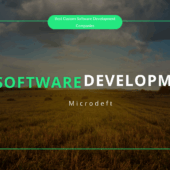Managing vendor relationships effectively is crucial for any business. From tracking contracts and ensuring timely payments to maintaining compliance and monitoring performance, vendor management can quickly become overwhelming without the right tools.
A reliable Vendor Management Software (VMS) centralizes all vendor-related data, simplifies processes, and enhances operational efficiency. With the right solution, businesses can automate workflows, track compliance, and optimize spending.
After testing over 10 tools, I’ve identified the 5 best vendor management software for 2025 to help streamline your operations, enhance security, and improve financial oversight.
Types of Vendor Management Software
Vendor management tools aren’t one-size-fits-all. They generally fall into three primary categories:
- Enterprise & Workforce Management: Tools like SAP Fieldglass help large organizations manage external workforce and vendor relationships at scale.
- Security & Compliance Management: Solutions such as Vanta focus on vendor security compliance, ensuring adherence to regulatory standards.
- Spend & Expense Management: Platforms like QuickBooks Online, Airbase, and Ramp streamline vendor payments, procurement, and financial oversight.
Key Features to Look for in Vendor Management Software
When evaluating the best vendor management software, consider the following critical features:
1. Vendor Performance Monitoring & Analytics
- Real-time tracking of vendor performance with KPIs such as delivery accuracy, response times, service quality, and SLA adherence.
- Built-in reporting tools and BI integration for data visualization.
- Customizable dashboards and automated alerts for performance deviations.
2. Contract Lifecycle Management (CLM)
- Automated contract creation, tracking, and renewal reminders.
- E-signature integration and version control for seamless document management.
- A document management system (DMS) for centralized and secure contract storage.
3. Integration with ERP & Financial Systems
- Seamless integration with ERP systems like SAP, Oracle, and Microsoft Dynamics.
- APIs and webhooks for real-time data synchronization.
- Export functionality to CSV, XML, and BI tools.
4. Risk Management & Compliance Tracking
- Vendor risk assessments, financial stability analysis, and compliance monitoring.
- Audit trails, risk scoring, and automated alerts for regulatory adherence.
- Built-in audit management for compliance reporting.
5. Centralized Vendor Data Repository
- Advanced search and filtering by vendor name, contract status, and performance metrics.
- Metadata tagging and full-text search for quick information retrieval.
- Categorization by strategic, preferred, or transactional vendors.
6. Cost Management & Budget Tracking
- Vendor spending analytics and budget tracking.
- Integration with accounting systems for automated invoice processing.
- Price change tracking and volume-based pricing management.
Top 5 Vendor Management Software for 2025
1. SAP Fieldglass
Best for Enterprise Vendor & Workforce Management
SAP Fieldglass is a comprehensive vendor management system designed for businesses managing large-scale vendor operations. It simplifies vendor onboarding, streamlines payments, and ensures compliance with labor laws and regulatory requirements.
Pros:
- Intuitive onboarding workflows.
- Consolidates payments, reports, and compliance tracking in one platform.
- Automates routine tasks like invoicing and contract renewals.
Cons:
- Time-consuming setup and integration.
- Slow customer support response times.
- Limited customization for some workflows.
2. Vanta
Best for Security & Compliance Management
Vanta is a top choice for businesses prioritizing vendor security compliance. It automates security monitoring, ensures compliance with GDPR, HIPAA, and SOC 2, and simplifies risk management.
Pros:
- Real-time security compliance tracking.
- Automated audit trails and risk scoring.
- Seamless integration with third-party security tools.
Cons:
- Higher pricing compared to competitors.
- Limited contract management capabilities.
- Requires technical expertise for full setup.
3. QuickBooks Online
Best for Small to Medium Businesses (SMBs)
QuickBooks Online is a widely used vendor expense management solution that integrates vendor payments, procurement, and financial oversight.
Pros:
- User-friendly interface and intuitive financial tracking.
- Seamless integration with banking and accounting tools.
- Automated vendor payment scheduling.
Cons:
- Not suitable for large enterprises.
- Lacks advanced risk assessment features.
- Limited contract lifecycle management capabilities.
4. Airbase
Best for Expense Control & Budget Management
Airbase is a powerful spend management platform that consolidates vendor payments, approvals, and expense tracking.
Pros:
- Real-time expense tracking with spend controls.
- Automated approval workflows.
- Integration with accounting software like Xero and QuickBooks.
Cons:
- Complex pricing structure.
- Some features require additional customization.
- Limited support for vendor contract management.
5. Ramp
Best for Automated Vendor Payments & Financial Oversight
Ramp is a leading AI-driven expense management tool, offering automated vendor payments, invoice tracking, and financial insights.
Pros:
- AI-driven spend optimization.
- Real-time budget tracking.
- No annual fees and cashback rewards on spending.
Cons:
- Lacks advanced contract management.
- No direct vendor risk scoring.
- Best suited for SMBs rather than enterprises.
Choosing the Right Vendor Management Software
When selecting a vendor management system, consider:
- Business size: Enterprises need robust solutions like SAP Fieldglass, while SMBs benefit from QuickBooks or Ramp.
- Compliance requirements: If security is a priority, choose Vanta.
- Financial management: Airbase and Ramp offer automated spend tracking and budget controls.
By implementing the right vendor management software, businesses can improve efficiency, enhance compliance, and reduce costs, ensuring seamless vendor relationships in 2025 and beyond.






